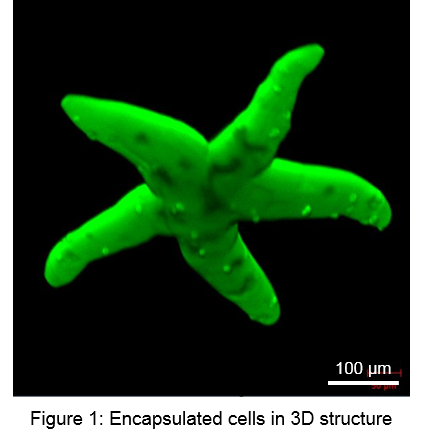Introduction: Hyaluronic acid (HA) is a polysaccharide, a major component in the extracellular matrix (ECM), and the basis of a large number of bio-inspired materials. In order to produce photo-crosslinked, biocompatible hydrogels it is necessary to introduce double bonds to the polysaccharide back bone. (Meth)acrylate-functionalization, however, is unsuitable due to the inherent cytotoxicity. The low cytotoxicity of vinyl esters along with the superior photo-reactivity as thiol-ene system[1] makes vinyl ester-functionalized HA an interesting candidate material for 3D biomaterial constructs manufactured by laser fabrication using two-photon lithography.
Materials and Methods: HA vinyl esters (HA-VE) were synthesized from HA with different molecular weights by lipase catalyzed transesterification with divinyl adipate (DVA) (Scheme 1)[2]. Macromeres were formulated with varied macromere contents and their reactivity was examined by photorheology. Furthermore, the influence of the addition of dithiothreitol (DTT) as chain transfer agent (CTA) was investigated. The slope of the storage modulus from rheometric curves was taken as a measure for the reactivity whereas the final storage modulus was used to calculate the mesh size of the hydrogels as reference value for the crosslink density. Additionally, the swellability of ready-cured hydrogels was determined. Cell compatibility of HA-VEs were assessed by metabolic as well as DNA assays. An exemplary HA-VE based formulation was used for the encapsulation of human umbilical vein cells (HUVECs) by two-photon polymerization (2PP) based microfabrication. The viability of the encapsulated cells was assessed by LIVE/DEAD staining.

Results: Two HA batches with different m.w. were converted to HA-VEs with different degrees of substitution (DS) resulting in six batches of HA-VE with different macromere size and DS. Photo-reactivity increased with macromere content, macromere size, and DS. Crosslink density followed the same trend, however, it was found that 80 mol% of thiol led to an optimized reactivity and final storage modulus. Swellability of hydrogels is decreased with increasing DS. Metabolic as well as DNA assay indicated the same trend for the cytocompatibility of vinyl ester-modified HA. The influence of the number of vinyl ester-groups (represented by DS) on the cytotoxicity of HA-VEs was found to be negligible. As a proof of the concept HUVECs were encapsulated in 3D hydrogel constructs[3] and found to be viable after 24 and 96 h (Figure 1).

Discussion: HA can be transformed to biocompatible HA-VE by lipase-catalyzed transesterification reaction with DVA in high yields. DS is easily adjusted by consideration of the reaction time. By variation of macromere content, macromere size, and/or DS the material properties can be adjusted and adapted to the demands. The cytocompatibility of the synthesized macromeres enables the fabrication of 3D hydrogel constructs with encapsulated cells by laser fabrication using two-photon lithography.
Conclusion: The modification of HA with vinyl esters in order to obtain macromeres that can be polymerized on demand by photopolymerization was found to be a promising modular material platform to engineer 3D hydrogel constructs as environment for living cells by laser based additive manufacturing technologies.
Austrian research funding association (FFG, project number 849787); European Research Council (Starting Grant-307701, A.O.)
References:
[1] Qin, X.-H.; Gruber, P.; Markovic, M.; Plochberger, B.; Klotzsch, E.; Stampfl, J.; Ovsianikov, A.; Liska, R. Polym. Chem. 2014, 5, 6523
[2] Torgersen, J.; Qin, X.-H.; Li, Z.; Ovsianikov, A.; Liska, R.; Stampfl, J. Adv. Funct. Mater. 2013, 23, (36), 4542-4554
[3] Hoyle, C. E.; Lowe, A. B.; Bowman, C. N. Chem. Soc. Rev. 2010, 39, (4), 1355-1387.